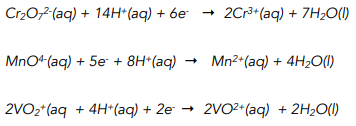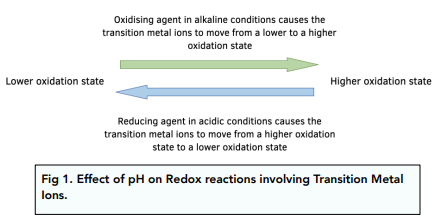Transition Metals - Redox Potentials (A-Level Chemistry)
Redox Potentials
Using Redox (Electrode) Potentials
Redox or electrode potentials can be used to predict how easily an atom or ion can be reduced to a lower oxidation state.
The larger (more positive) the redox potential, the more likely the ion / atom is to be reduced.
Redox potentials are not necessarily the same as standard electrode potentials, as they depend on the pH and types of ligands involved.
Effect of pH
The redox potential for changing a transition metal ion from a higher to a lower oxidation state is influenced by pH.
The effects of pH varies between reduction and oxidation reactions:
- Reduction – Reduction of higher oxidation state transition metals tends to happen in acidic conditions. Here are some examples:

- Oxidation – Oxidation of lower oxidation state transition metal ions tends to happen in alkaline conditions. An example of this is Fe²⁺ ions are readily oxidised to Fe³⁺ ions in alkaline conditions.

Effect of Ligands
Different ligands may affect the redox potential. This is because different ligands will bind more or less strongly to the metal ion in a particular oxidation state.
Here is an example:

The redox potentials show that it is easier to reduce [Co(H₂O)₆]²⁺ (more positive redox potential) compared to [Co(NH₃)₆]²⁺ .





Still got a question? Leave a comment
Leave a comment